Because all of the pictures below are broken. Very sorry for this inconvenience, that my computer crushed and lost all pictures I had.
--------------------------------------------------------------------------------------------------------------------------------------------------------------------------------
Once I had made my raisin yeast water, I really didn't care about methods to make - I had mine, and that was all I cared about. After I was asked by some TFL members about yeast water, I realized that I really didn't know what the nature of raisin yeast water was. I 'd like to leave my recent research and thoughts here for anyone who is interested in for reference.
How to make raisin yeast water
Ingredients:
- 45 g Raisins( * I use organic Thompson raisins. they are NOT coated with oil, I recommend to use organic one)
- Water ( I used purified this time, I also use filtered water from a refrigerator. NO using chlorine water .
- A jar ( I use emptied jelly jars all the time.)
Day1:
1) Sterilize your jar: put the jar in the boiling water for a few minutes and take it out . Leave it until it is dry.
 2) Add the raisins and the water as to 1:1 ratio like the picture below.
2) Add the raisins and the water as to 1:1 ratio like the picture below. (No chlorine water! It kills yeast!) 3) Shook the jar vigorously * Tighten the lid
(No chlorine water! It kills yeast!) 3) Shook the jar vigorously * Tighten the lid Before shaking
Before shaking After shaking vigorously /
After shaking vigorously /  Close up4) Keep the jar at 82 F / 28℃. * Tighten the lid
Close up4) Keep the jar at 82 F / 28℃. * Tighten the lid ( The right one is correct. the left jar is the other way to make yeast water )5) 4-5 hours later : * Keep the jar at 82 F / 28℃. Tighten the lid
( The right one is correct. the left jar is the other way to make yeast water )5) 4-5 hours later : * Keep the jar at 82 F / 28℃. Tighten the lid  Before shaking
Before shaking After shaking vigorously * The raisins are soaked with the water. Now it is the time to add more water.6) Add some purified water until double the raisins.
After shaking vigorously * The raisins are soaked with the water. Now it is the time to add more water.6) Add some purified water until double the raisins.  After shaking vigorously,* Keep the jar at 82 F / 28℃. Tighten the lid
After shaking vigorously,* Keep the jar at 82 F / 28℃. Tighten the lid Day 2 7) Shake the jar vigorously as many as you can. * Keep the jar at 82 F / 28℃. Tighten the lid
---- I did that was 6:30 am ~ 8:20 pm --- shook the jar vigorously 13 times. * Tighten the lid* All of the raisins stayed up to the top of the water. 6:20 am
 Before shaking
Before shaking  After shaking vigorously * Tighten the lid
After shaking vigorously * Tighten the lid8) At the night *Close the lid not too tight not too loose.
 * I think that the yeast needs to get some little oxygen to breath to activate for over night so I didn'tclose the lid tight anymore because the raisins stayed up to the top of the water for a half day.Day 39) In the morning Shake the jar vigorously. *Close the lid not too tight not too loose
* I think that the yeast needs to get some little oxygen to breath to activate for over night so I didn'tclose the lid tight anymore because the raisins stayed up to the top of the water for a half day.Day 39) In the morning Shake the jar vigorously. *Close the lid not too tight not too loose Before shaking
Before shaking  close up
close up After shaking vigorously
After shaking vigorously  Close up10) Refrigerate it when you hear shwwwwww... sounds while it was fermented at 82 F.). *Close the lid tightly after shaking vigorously.
Close up10) Refrigerate it when you hear shwwwwww... sounds while it was fermented at 82 F.). *Close the lid tightly after shaking vigorously. Day 411) in the morning: *Close the lid tightly after shaking vigorously andPut it back in the refrigerator .
Day 411) in the morning: *Close the lid tightly after shaking vigorously andPut it back in the refrigerator . Before shaking
Before shaking  Close up
Close up After shaking vigorously
After shaking vigorously  Close upDay 512) In the morning: Shake the jar vigorously. Tighten the lid and put it back in the refrigerator.
Close upDay 512) In the morning: Shake the jar vigorously. Tighten the lid and put it back in the refrigerator. Before shaking * I smell a bit strong alcohol smell which means fully fermented but it needs more rest before baking bread.
Before shaking * I smell a bit strong alcohol smell which means fully fermented but it needs more rest before baking bread.
 After shaking vigorously * The alcohol smells was weaken.( mild level)13) At the night( Approximately 12 hours later)-- READY TO BAKE!To make levain for my sandwich loaf with raisin yeast water.Levain:
After shaking vigorously * The alcohol smells was weaken.( mild level)13) At the night( Approximately 12 hours later)-- READY TO BAKE!To make levain for my sandwich loaf with raisin yeast water.Levain:- King Arthur all purpose flour 149g
- Raisin yeast water 107g
 The taste: Sweet and little bit of alcohol.The result of the PH level test
The taste: Sweet and little bit of alcohol.The result of the PH level test Between PH 5.5 and 5.75.
Between PH 5.5 and 5.75. Added 149 g KA AP and made the levain.Viscosity: Hard. I had to knead by hand.* "Hard " means that there is a lot of sugar in the dough.------------------------------------------------------------------------------Next day--- Final dough
Added 149 g KA AP and made the levain.Viscosity: Hard. I had to knead by hand.* "Hard " means that there is a lot of sugar in the dough.------------------------------------------------------------------------------Next day--- Final dough- King Arthur bread flour 281g
- 1 egg yolk + Whipping heavy cream=58g
- Water 144g
- Sugar 13g
- Butter 29g
- Salt 6.8g
- Mix all the final ingredients and the levain except the butter and salt.
- Autolyze 30minutes.
- Add the salt and butter and knead until you pass a window pane test.
- Bulk fermentation at the room temperature until triples.
- Preshape
- Shape
- Bake 35 minutes at 410F until golden brown. *Cold oven method: Spray a couple time in the oven and put the loaf in. Set up 284F for 20 minutes. increase the temperature to 410F for 10 minutes, lotate 180 degree the loaf pan and bake 10 more minutes until golden brown.
 The levain rose tripled ( 9 hours later)
The levain rose tripled ( 9 hours later) Bulk fermentation: The final dough rose almost tripled in 5 hours at 72-73F.
Bulk fermentation: The final dough rose almost tripled in 5 hours at 72-73F. Final proof: The dough rose over the top of the tin in 2 hours at 82F.
Final proof: The dough rose over the top of the tin in 2 hours at 82F. Baked for 35 minutes at 410 F.( I couldn't use " cold oven method" because I was using the oven a hour ago before )
Baked for 35 minutes at 410 F.( I couldn't use " cold oven method" because I was using the oven a hour ago before ) When I ferment the final dough at colder temp, I can see the cracks.
When I ferment the final dough at colder temp, I can see the cracks.
 The taste was really good. nice volume. The crumb was not wet, it was nice texture.I smelled a bit of fruity smell from the raisins when I sliced it after 5 hours I baked, but the smell was very slightly and very pleasant.------------------------------------------------------------- Comparison:5/267 :00 am--
The taste was really good. nice volume. The crumb was not wet, it was nice texture.I smelled a bit of fruity smell from the raisins when I sliced it after 5 hours I baked, but the smell was very slightly and very pleasant.------------------------------------------------------------- Comparison:5/267 :00 am-- From left: No lid / Vigorous shakes/ my old one - generous shakes10:30 am--
From left: No lid / Vigorous shakes/ my old one - generous shakes10:30 am-- From left: No lid/ Vigorous shakes/ my old one5/27 5:50 am
From left: No lid/ Vigorous shakes/ my old one5/27 5:50 am From left: No lid/ Vigorous shakes/ my old one (I just refreshed)Comparison of the crumb:
From left: No lid/ Vigorous shakes/ my old one (I just refreshed)Comparison of the crumb: ( 12 g sugar not 13g used in the final dough)
( 12 g sugar not 13g used in the final dough) Vigorous shakes
Vigorous shakes  No lid* I didn't like No lid bread because I smelled strong yeast like Active dry yeast when I put it in my mouth.
No lid* I didn't like No lid bread because I smelled strong yeast like Active dry yeast when I put it in my mouth.

 No lid raisin yeast water itself has no strong yeast smell neither taste , which gave me a surprise.Our taste gives us more details than this PH test in my opinion.----------------------------------------------
No lid raisin yeast water itself has no strong yeast smell neither taste , which gave me a surprise.Our taste gives us more details than this PH test in my opinion.----------------------------------------------For reference, I want to mention about yeast water that I found from some Japanese sites and the others from winery .
"Yeasts will activate in two different ways:1. with oxygen:
- {Sugar -C6H12O6+Oxygen--O2}→{ Carbon dioxide-Co2+Water -H2O}
- (* We call it " Breath" which means the yeast is active. )
2. with no oxygen:
{Sugar-C6H12O6 }→{Carbon dioxide gas 2(CO2) + Alcohol(Ethyl alcohol)-2(CH3CH2OH)}
(※ We call it "Alcohol fermentation")When there is no sugar in, it turns to acetic acid ( quite sour), except apple and raisin which contain malic acid. ( milder )
When we make raisin yeast water using a jar, The yeast water will activate with the oxygen in the jar first ( Breath), and occur alcohol fermentation when it is no oxygen in the jar. Alcohol has bactericidal action which prevents to have mold and unwanted bacteria. Natural yeast is tolerant to alcohol so that they live together, however, he doesn't grow without new oxygen.While alcohol fermentation is working, natural yeast stops growing, therefore, it is not time to congratulate yourself yet because of the bubbles ( carbon dioxide gas) , you have to get more oxygen to have your yeast water activate by loosing a lid to access air ( oxygen) into your yeast water.
To make non sour bread, grow Saccharomyces cerevisiae ( S.ellipsoides) in the raisin yeast BEFORE Lactic and acetic acid bacterias grow at proper temperature. Saccharomayces cerecisiae will be tolerant to them. ( Saccharomayces cerecisiae >Lactic acid and acetic bacteria)*Lactic bacteria and acetic bacteria are in the air. Especially acetic bacteria increases in summer. They exist in the air and grow in all kind of fruit and vegetables and other kind of food that they contain glucose. To make kimchi, we use the power of lactic bacteria that is in the Chinese cabbage. Japanese sake is also used the power of lactic acid bacteria that is in the rice. Acetic bacteria will really activate at over 30℃. To make sweet raisin yeast water ( or other fruit yeast), We should fully grow Saccharomyces cerevisiae ( S.ellipsoides) in the raisin yeast ( or other fruit yeast) BEFORE lactic and acetic bacteria grow. Lactic bacteria is not bad when we make yogurt yeast to make sweet bread. When Lactic bacteria is fully grown in yogurt yeast, Other unwanted bacteria can't grow in the yogurt yeast because the lactic bacteria is tolerant to them at proper temperature. * Exception: Sourdough
-----------------------------------------------------------------------------------------------------*How I maintain my raisin yeast water: *Use a sterilized jar and filtered water. (no chlorine water)

*And the raisins are NOT coated with OIL. Organic ones taste much better.
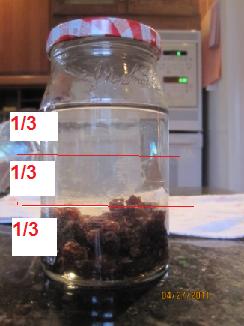
* I don't measure the water actually but by volume like the picture above.
Ingredients:This volume will be about- 13-25g raisin yeast water (5-7% -in the summer 10-11% in the winter) * The temperature by the snake light differs from all season so that I adjust the raisin yeast water amount by the room temperature.
- 45 g raisins (20%)
- 225 g water ( 100%)

If you store it more than several days, I will *refresh it before baking.*Using this maintain raisin yeast water method.
Here is the link that you might be interested in:http://en.wikipedia.org/wiki/Yeast--------------------------------------------------------------Other methods that I found in Japanese sites1)http://levadura.exblog.jp/12421595/I read one of Japanese home baker’s method of making raisin yeast water: To make non sour (sweet) and well risen bread, she tighten the lid and shake the jar gently once or twice a day during the process, and she said" if you make bread with this yeast water, you will have dense bread because the yeast didn't get enough oxygen while it was fermented although the taste is wonderfully sweet. In according to make bread that has volume, she add mashed mixed fruit in the yeast water to ferment it again in a bowl that is covered with plastic wrap at room temperature .It sounds good, but it will give me more work. I rather make raisin yeast simply in good condition.
2) No lid method:
http://cookpad.com/recipe/543057 She tested 2 kind of methods between with lid and no lid like me. She said that No lid doesn't have any alcohol smell and rise very well. She is right but I had a different result after baking. I smelled alcohol from the crumb and the crumb remains wetter in the crumb but I also think that no lid one rise well in the oven.
This is the result:
----------------------------------------------------------------------------------
Q & A:
Q: Does the taste of yeast water affect to the bread?
A: I say " Yes" That is why I smell and taste my raisin yeast water if it is fine. My raisin yeast water is sweet with mild alcohol generally. When the raisin yeast water is just made, You may smell strong alcohol, but it will be milder and read to bake in the next day. If you smell sour or funny, I strongly recommend you to throw away all of your raisin yeast water, and make a new one.
--------------------------------------------------------------
Q : Why do you shake it vigorously during the process?
A: I have two purposes. I can squeeze more sugar to feed the raisin yeast water by the vigorous shakes, which also activate the raisin yeast.I don't recommend this technique for fresh fruit yeast water which have bitter skins because the bitters remains in the yeast water and the bread.
----------------------------------------------------------------------------------------------
Q: Can I use a water bottle to make raisin yeast water ?
A: I prefer a jar. It depends on you. However, I highly recommend not to use a weak water bottle like "Walt-mart" brand.I tested it before. On the second day, I smelled some chemical from the bottle. Although I noticed that the raisin yeast water in the bottle had a lot of bubbles and very active, which reminded me of the process to make beer.http://www.youtube.com/watch?v=sSrbukazO_Q
Day 1 Day2


------------------------------------------------------------
Q: How do make bread with raisin yeast water?A: I use my yeast water like sourdough I used to have.Example: http://www.thefreshloaf.com/node/23726/thank-you-syd I also use my raisin yeast water as sherry wine or mirin ( sweet Japanese sake for cooking) to make teriyaki sauce, orange sour chicken sauce, and so on. I also keep my alcoholic raisins that are fermented in the jar for home made rum raisins. So I can make Daisy's Panettone.http://www.thfreshloaf.com/node/21104/my-first-panettone-milanese-notes-trial-run-formula-and-method-thanks-all-advice Once, I used 2 tbsp this rum syrup to fix the sour flavor when I made David's miche:http://www.thefreshloaf.com/node/23593/david039s-miche-raisin-yeast-water ( NO.5)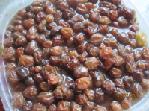 Home made rum raisins.I add some sugar in whenever I add more alcoholic raisins.I discard the raisins that I make raisin yeast water from beginning because they are smashed and less sugar left in them.
Home made rum raisins.I add some sugar in whenever I add more alcoholic raisins.I discard the raisins that I make raisin yeast water from beginning because they are smashed and less sugar left in them.-------------------------------------------------
Q : Is it okay to smell strong alcohol from my raisin yeast water?
A: Yes. When the raisin yeast water is just made, You may smell strong alcohol, but it will be milder and read to bake in the next day. Also,If your raisin yeast water is kept in the refrigerator for a couple days only, It will be fine. If you smell it strong, I will shake the jar vigorously. The smell will be weaken. It is very important to see how active your raisin yeast water is. Very healthy one is the raisins keep floating around the top of the water, and you can hear strong pops ( shwwww..) when you shake it and open it up.Here is the result of a sandwich loaf when I used my old raisin yeast water that was little strong alcohol smell.https://www.evernote.com/shard/s46/sh/039147ff-264d-4fa4-959d-65cf8cab1c3c/94659bd4a5655d3db0b0b2d4ddc79392------------------------------------------------------------
Q: How is it different from between non organic and organic raisins?A: I have some experiments using Sun-maid raisins ( golden and regular ones)
Regular one is okay, but I tasted weird flavor in the bread a little bit when I compare to organic one.I strongly recommend not to use sun-maid golden raisins. It smelled and tasted very weird.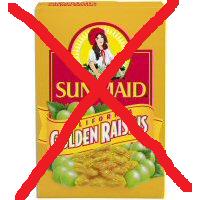
------------------------------------------------------------
Q: Is it okay that my raisin yeast water sank on the bottom in the refrigerator?A: This is depends. If all of the raisins doesn't float back up to the top of the water within a day after shaking vigorously, I think that the yeast is weak or some unwanted bacterias are in it. I did throw it away and made a new one when I had the problem. It happened when I didn't take care of the raisin yeast water for a couple weeks.------------------------------------------------------------
Q; What temperature is better to make bread for raisin yeast water?A: For Levain bread:
In the summer, I use colder temperature around 70-73 F for bulk fermentation, 70-76 F around for final proof .
In the winter, The temperature is around 76F for Bulk fermentation, 70-76F for final proof.
I think that raisin yeast water bread is not sour unless you retard it for a long time. But it differs from what king of flour you use. Rye and Whole wheat flour give it more acid or earthy flavor.
Happy baking,
Akiko
- teketeke's Blog
- Log in or register to post comments
Akiko, you have given others a great deal of information in your posting. I am sure others will greatly appreciate all you have done.
I know you helped me a great deal with all of the other translations from Japaneses bakers using YW, and I certainly appreciated that, too. Thank you.
Ron
Ron,
Your compliment means a lot to me. You helped me so much that I learned from your experiments with yeast water. I have enjoyed to read all of your posts that are well written.
I also appreciate all your work, Ron. Thank you, too.
Akiko
Wow! Great write up and explanation. So much information and detail to share. Terrific!
-Pamela
Thank you again for your kind word, Pamela. I hope some of information will be helpful to your future experiment of your yeast waters.
Best wishes,
Akiko
Akiko,
Once again I am impressed with all of the work that you have put into studying YWs and translating it all for us here so we can grow and bake with it too!
This latest write up of yours is no exception! I love how you have included photos showing exactly what happens under what conditions. Makes this all so much easier to understand.
I am also amazed that you have time to do all that you do and you do it so well! I can see you are a very busy woman!
Thank you for everything !!!!
~Janet
Hi Janet,
Your very welcome, and I am very glad that this post makes easier for you to understand. I am very pleased with your words.
Thank you, too :)
Akiko
Hi akiko,
I would say this is one area where TFL is really pushing the boundaries in today's real bread baking arena.
Thank you to all those who are contributing to this debate, especially yourself, and Pamela and Ron at the top of the post.
Not something I've done much of myself. We used to make a "raisin must", by soaking raisins overnight and pureeing them down to add to Spelt bread as a sweetener. That's about it. I need to bring my copy of Jan Hedh's "Artisan Baking" home, and work out some formulae using all the info you have put up on TFL.
Thank you for posting all this
Best wishes
Andy
Hi Andy,
I am very happy to get great words from you whom I see as a great professional baker .
"raisin must" made me think of another way to make raisin yeast water. Once, I smashed some organic raisins ( no soaker), and add some water and old raisin yeast water to maintain. It came out sourer yeast water ( fruity) when it was fully fermented . I like to smell and taste the fruity sourness when I make pocky. :)
http://www.thefreshloaf.com/node/23680/tomato-pretzel-yeast-water-raisin-yeast-water-used
Although some Japanese bakers like to use this method to bake bread that have pinch of the fruity sourness.
" raisin must" is like my English muffin. Raisin soaker is wonderfully sweet. Thank you for mentioning about Jan Hedh's Artisan Bread book. I will study. :)
Best wishes, too
Akiko
I'm just messin' round.
-Pamela
I do that sometimes :)
Akiko
Everything I want to say has been said already. I have learnt so much from you Ron, Pamela and Janet in the past 6 weeks and my breads havesignificantly improved since I started using raisin yeast water in my dough. I don't think I ever want to go back to using IDY in my breads. Whilst I like to experiment with other dried fruits, I think raisins will remain my favourite source for it's reliability and ease of maintenance. -Judy
Your welcome, Judy :)
I am glad to know that you have succeeded on your bread with yeast water. I also found that raisin yeast water is easy to maintain. Some Japanese professional bakers also use raisin yeast water, too.
Happy baking,
Akiko
My bread book has a chapter on raisin yeast water and one other fruit to use to cultivate yeast water was the Japanese Ume (green plums). We don't see much of this in HK (maybe not in season now) but this would make a lovely yeast water for it fragrant and refreshing taste. - Judy
Thank you for the information, Judy
I looked up some results of ume yeast water that some Japanese home bakers made. some of them said that ume yeast water itself is very active, however, the levain,final dough and the loaf while baking don't rise much. And the other one said that it rises well. All of them mentioned that the dough is wetter. It will be interesting if I try. I may look for ume around here.. It is season in Japan now.
1)http://blog.livedoor.jp/bagel_lab/archives/1451258.html 2)http://blog.livedoor.jp/bagel_lab/archives/1459819.html -- ( Levain method) She fermented the final dough at cooler temperature, she had a nice volume loaf although she said that the loaf didn't rise as much as she expected.
3) http://ameagarinosora.blog71.fc2.com/blog-entry-23.html ( straight method) She said that she tasted acid and the texture is chewy a bit. The first proof took overnight. ( It rose tripled until then)
4)http://nyoron38.blog.so-net.ne.jp/2010-06-30 ( Straight method) She said that she smells ume from the bread. She overproofed the final dough at bulk fermentation because she kept the dough at the room temperature for overnight. She didn't taste ume sour in the bread but tasted acid a bit. She also said that this bread is easy to eat because there is not typical flavor.
5)http://72768102.at.webry.info/200906/article_17.html ( ?) She said that the dough was really sticky to deal with, and it didn't rise much because the dough was slack. but she liked it because she put some raisins in it.
Here is about ume, I will leave it for reference for everybody :http://en.wikipedia.org/wiki/Prunus_mume And, Ume contains high citric acid and some an organic acid that are really good for our health :http://en.wikipedia.org/wiki/Citric_acid
Best wishes,
Akiko
you're like a walking encyclopedia!! Alway ready with whatever info needed and I am truly thankful for the time you have spent to look this up for our benefit. It takes a lot of sugar to ferment Ume, according to my book, it needs 120 grm sugar for 200 grms of the fruit and only 100 cc water. When the water is ready, it is then fed twice a day with 2T bf/1.5T water and .5t raw sugar and then throw out half every two or three days. I don't want to be lumbered with the task of feeding it daily and throwing out the flour but wouldn't mind making a yeast water with Ume if I can find the right fruit as I understand there are many different kinds of Ume.
- Judy
Thank you for your kind word, Judy!
Your book seems very good. Thank you for telling me the method of Ume yeast water, which is very interesting to me. In your book, Do you poke the green ume with a toothpick or fork to ferment easily? I looked up for the method for Ume, but I couldn't find the one that has more detail to post it here. I read some of them recommend to ferment the Ume with some raisins or some sweet fruit to make non sour bread, but you book seems great to make pure Ume YW bread. If you try, Please let us know how it turns out.
Best wishes,
Akiko
It says to give each ume 2 - 3 slashes/cuts on the skin (no need to cut in half) but will need plenty of sugar due to the sourness. I seldom see fresh ume being sold in HK, but if I see them I'll def. give them a try.
- Judy
I will look for some fresh green ume here too! Thank you for your information, Judy!
Akiko
After reading the findings you posted, it seems that the ume fruit is not such a good choice after all in spite of it's wonderful fragrance. Maybe they are better off being used in the making of the famous ume wine and pickled ume to go with fatty tuna bento :-D - Judy
Judy, I think your ume YW method from the book may give you a good result because The ume YW during the process is discarded some of them and refresh it with new water and so on. Is there any pictures of the crumb of the ume YW bread in the book? Are there any details of the taste ?
Best wishes,
Akiko
Unfortunately, instructions are only given on the making the yw and flour is fed twice a day, it doesn't say when to stop feeding, but to discard half after feeding for a couple of days, I think it's very similar to making a sourdough starter? The same applies to their method for RYW where you just keep feeding and discarding. There are some recipes using mostly 300 grms flour and 200 grms of the natural yeast starter. Now that I understand more about builds, I would prefer to make a multi-build 200 grms levain (less wastage) rather than to feed it continuously and then discard, although I'm not sure if the result will be the same. - Judy
-
Thanks Akiko, this is great. I am bookmarking it for when I have more time. I hardly have time at the moment to maintain my sourdough starter let alone bake a loaf of bread or start a new adventure, but as soon as I have the time, this is going to be my next project. Very thorough, as always. :)
Syd
Thank you for your compliment, Syd! I certainly understand your situation. When I had sourdough and rye sourdough starter, I tried to make raisin yeast water 1 year ago. It was a failure. I didn't pay attention to the raisin yeast water much. I just left the raisin yeast water jar on the window that had a lot of sun that is taboo. That was wrong that I heard it was really easy to make without much care. I hope you will have fun with your new adventure when you try it.
Best wishes,
Akiko
Hi Akiko,
Thank you for the detailed write up especially the Q & A parts. I totally agree with you in term of mineral water issues, for those who wants to use mineral bottle water please be sure the bottle is sturdy enough that can handle well with pressure. Thank you again.
Kimmy
Hi Kimmy,
Thank you for your very kind words. I think that is a good point of the bottles for yeast waters.
Happy baking,
Akiko
It is a nice updating... :-)
Ron
When I took a look at this a couple days ago, I thought that was really complicating! LOL
So I organized it a bit. Thank you for your kind comment! :)
P.S I used your "OAK WOOD" method to make a small sandwich loaf. :) Although I just covered a little piece of wood that fits in my pullman with foil.
Happy baking,
Akiko
That is good. It is nice to be able to use the Pullman for loaves less than full size. It has worked well for me, as too ;-)
Ron
Hi Ron,
Yes, It worked very well and I am pleased with it. You can invent something very interesting like your sourdough cracker and this! :)
Akiko
using Minneola tangelos and apples. The Minneola pulp clouded the water so much I couldn't see any bubbles but there was a little 'swish' of air when I opened the jar. Tody at day 6, I drained off the water and reserved the solids. I put the water back in the jar with a pinch of sugar and another 1/2 of an apple. Should I have put all the water back or half with some new water? I took the solids and about a tablespoon of the juice and mixed it with about 2 T of flour hoping I can see some signs of life in it.
Have I done the right thing with my YW? When can I refrigerate it and what should I do to it before I cool it? Any help would be most helpful.
I just love the TFL site after being here a week or so.
Welcome to the TFL, and I am very glad to hear that you seem enjoying here. It is very nice to place to learn about baking, isn't?
It doesn't look good on your yeast water... Were the Minneola tangelos waxed? If they are waxed, It may not work well. Any kind of fruit or dry fruit should have no oil on them. I also recommended not to shake a jar so much (such as I make raisin yeast water ) when you use fresh fruit that have bitter skin for making yeast water.( that is fine if you peeled the skin of the fruit.) The taste of the bitterness may remain in the bread, which I had the experiment from grape fruit yeast water.
I have less experiment for multi fruit yeast water. ( cloese to zero...) One of Japanese home bakers smashes all of the fresh fruit by a blender and fermented it in the jar. It works well for her, and her bread look great, too.
Happy baking,
Akiko
I also read on Ray's blog not to put the peals of citrus in the YW so I drained it off and took out the peels after day 2. At day 6 I also strained off all the solids and put the water back with new apple only this time. I also tried to see if I had any yeast working so I tried to make a levain by using a couple peieces if the old fruit with a tablespoon of the yeast water with water with 2 T of AP flour. Since I actually had two YW experiments going, I did the levain test for each and fed the levain twice a day since day 6.
I am happy to say that I am the daddy of 2 new alive yeast waters since both produced viable levains. I am now building them both up for breads. I just wish I could see the bubbles in the YW. I think with time the water will clear as I remove the liquid and replace it with clear water.
What should adn how do I feed these beasts? Thanks so much for all of your help.
Amirigato and konichiwa (Your English is much netter than my Japanese)
This has to be one of the best sites on the Internet?
Koneichiwa
Hi dabrownman,
Oh my goodness, I am sorry that I misspelled on the one that I responded to you. Thank you for your kind words for my English :) I think that I can improve my English whenever I humiliate myself by making a mistake.
Your levain sounds very good! I am glad to hear that your good news!
About your yeast water : Could you explain how you ferment your apple yeast water now? Temperature is the most important. 28 ℃ or 82 F is good. It is too low temperature, your yeast water won't be active. How do you keep the jar ? ( do you tighten or loosen the jar?)
P.S Kon-ni-chi-wa ( こんにちは) Arigato(u )(ありがとう) :)
Good luck to your yeast water,
Akiko
" I think that I can improve my English whenever I humiliate myself by making a mistake. " Fear, pride and ego are only three character attributes that lead to failure. Some people fear failure so much they won't even take the first steps to solve a problem or fix what is broken or try something new. They do not realize that some problems can only be fixed by failing miserably. You say "what a mess, I wish I would have done that instead". Well then go do that and see if that works - it probable will work out at least as good as the first attempt :-). People don't humiliate themselves by making a a mistake if they learn from them. I speak from experience when I say that one can gain satisfaction by failing their way all the way to the top. Your English is as good as mine and you should be proud if it. Back to yeast water.
I used store bought organic apples, not washed by me and Minneolas from my tree in the back yard also not washed. Day two I got rid of the peels and I don't think any harm was done. When I drained them off on day 6 and removed the solids, I just put new apples back on top. I put about 1/2 tsp of honey in the plastic peanut butter jar (3"diameter x 5" high) where the YW is contained to feed them every other day or so now. I keep the lid loose and nt quite tight, as I think you suggest, and I stir them twice a day with a spoon. The ttemperature is 70 degrees today, it is wintertime in AZ, but the YW is bubbling away very well today. I gets down to 64 degrees F at night. I have some questions
What should I feed them? When should I feed them - how often? When can they go in the refrigerator with the rest of my starters? Should I be removing water when I feed them and add new water to refresh the jar? No need to have 2 of the same YW so I dumped one earlier today, keeping the one that seems to be doing the best. I noticed that it takes linger to build up levain for bread - on day 2 now feeding twice a day with AP. Tomorrow I think I will have enough stiff levain to try out on some bread. I'm going to try and find a recipe that will work well with both orange and apples. Now I have 1 Minneola/ apple YW, 1 Minneola SD and 1 milk SD starters. My wife says 3 is the limit :)
後で会おう
Hi dabrownman,
Thank you so much for your very kind words for my English, and your thoughts makes sense. Certainly I was the one of them who avoided to talk to people as possible as I could in English. I changed my attitude since I joined on TFL. Baking is my most favorite thing. I can focus on what they write about bread that I really like without thinking that I might humiliate myself. Thanks to this, Now I am freely to talk to people in person, too. Thank you so much again for your great thought.
About your yeast water:
I think that you better wash these fruit before using. ( not too much, but wash them lightly )
Leaving skins are very important because the skin is the only one place that the yeasts are living in. I just warned you not to use skins that have bitter skin. Did you peel the apples too?
You don't have to drain them off... Keep the fruit that you started in the jar until it is fully fermented.
Generally, adding 20% sugar or honey as to the total weight of your fresh fruit at the beggining. You might not need any more feeding until it is fully fermented. If you don't see any bubbles, feeding some sugar or honey may help. Some people feed more fresh fruit or the other kind of fruit to their yeast water while fermenting.. but I never have the experiment.
I would keep tightening the jar and shaking vigorously as much as you can until you can hear " SHWWWWW" after shaking the jar vigorously ( it will take 24-48 hours until you can hear the sounds ) This process will produce Alcohol fermentation, which prevent have unwanted bacteria while fermenting at the final step. Then keeping the jar loose so that your yeast water can breath and the yeast grow stronger. This process will have breath action.
NO! You have to keep your precious yeast water at 80-82F. I know that is difficult to keep it warm in the winter. But I live in NY and my kitchen is around 64F in the morning and night too. Please get a stand light that have a flexible neck like this. So you can warm your yeast water.
I started to make apple yeast water for interest today. This is the second try for the apple yeast water. :) At the first try,I added honey for the 20% sugar as to the apples. But this time, I added 20% sugar as to it. I want to see how the apple yeast bread turns out.
I will show you how I started to make this apple yeast water.
1.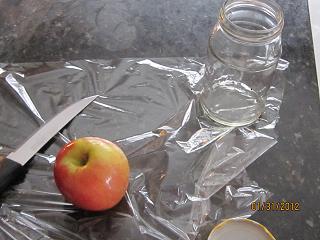
Preparing A Sterilized jar, a lightly washed small apple ( no waxed), Water ( No chorine water) and a clean knife.
2.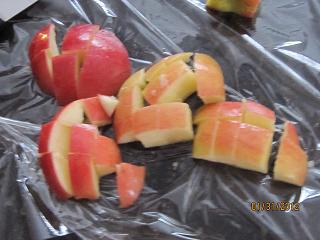
Cut the apple in small pieces.
3.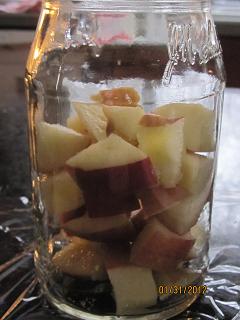
Put all of the diced apple in the jar. (The apples weight 107g.)
4.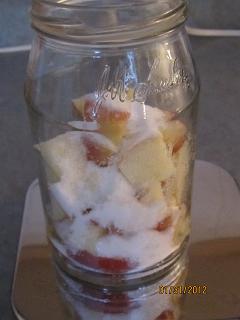
Add 20% sugar which means 21g sugar in the jar.
5.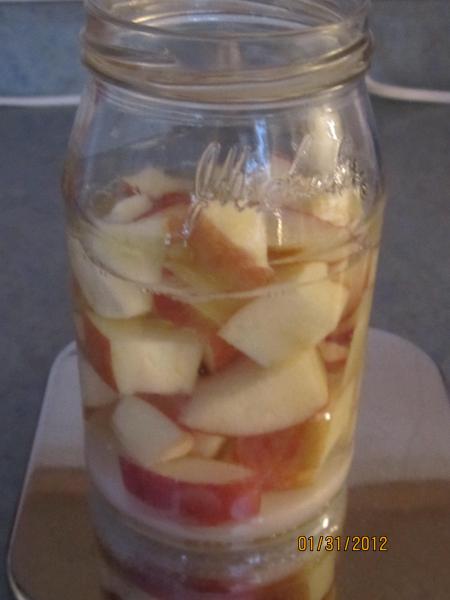
Add some water until covering the apples. ( the water weight 135g) --- I will add more water when the apples need more water to be covered with. The apples should be covered with water all the time.
6.
 I keep tighten the jar until you can hear " SHWWW" sounds. I will shake 20 times a day or so...
I keep tighten the jar until you can hear " SHWWW" sounds. I will shake 20 times a day or so...
7 4 hours later after I started. The apples look thirsty..
4 hours later after I started. The apples look thirsty..
To be continued...
Now Back to your question,
20% Sugar or honey when you start your fruit yeast water.. You don't need add any sugar for dry furit that contain enough (plenty of ) sugar already. You don't have to feed your baby yeast water while fermenting except it is not active or not seeing any bubbles.
For the starter... Yes, you can keep it in the refrigerator, but you may need to refresh if you keep it for more than 3 days. I keep my starter at the room temperature and feed once a day. I don't make sourdough with it often but I feed it to my chickens who love sourdough..
No, If you remove the water, the yeast will be weaker and weaker.... The apples themselves are not the mother yeast. The water is the mother yeast.
That is a wise chose. You can concentrate on the one thing.
I always keep my yeast water in the refrigerator, and I refresh it every 3 days or so. I am a frequent baker so that I have to refresh to make another one very often.
To refresh apple yeast water.... I will put 20g mother apple yeast water ( In general, 20-25g mother yeast water in the winter, Around 10-15 g in the summer ) , a small diced apples, and 80% water as to the jar and ferment it at 76-80F for overnight. It will be fully fermented by then. I will put the apple yeast water without draining the apples in the refrigerator as soon as it is fermented fully. I will keep the apples in the jar so that my apple yeast water will be fed by the apples in the refrigerator. Every sourdough or yeast water need some sugar even though they sleep in the refrigerator because they are still living and eating in the container gradually, otherwise they will be starve and sour.
To bake bread with the fresh yeast water, I will wait for a day or two days. So the apple yeast water will be very stable to enough make good bread.
P.S A nice Japanese word that you typed!
Good luck,
Akiko
I did rinse the fruit but did not wash it with soap. I kept the skins on the minneola and the apple but took th skins of the minneola out on the 2nd say when I found out not to use the skins of citrus. Am now following youir directions and fed the YW today, let it get real active again and then will store it in the fridge tomorrow. It is at 82 degrees. Your process for AYW you photographed above is now very clear. It really isn't hard once you see the pictures.
I am still building my YW levain and will have enough to make some bread with it tomorrow. Now I have to find a recipe I like.
親切な友人をします。Hi dabrownman,
You're very welcome, and I have to applogize my big mistake.
I made a big mistake on the response above.
You can refrigerate it when you hear the strong " SHWWW" sounds. And, 24 hours is too early to loosen the jar yet. I am very sorry for this mistake.
I am glad that you didn't use soap to wash your fruit. The point is just get rid of some dust or bugs by washing with water. But washing fruit too much is not good to make strong yeast water. we need to keep the yeasts in the skin.
That is good thing. I see some Japanese home bakers leave the citrus skin in their yeast water, but I really didn't like the flavor and crumb.. You can try it if you are interested in, but I don't recommend you to use it for your first try.
I am glad that these pictures helped you. It is very easy to make yeast water when you get some right points. It may be good to make a levain as a test ( If the levain rises doubled in 12 hours, your yeast water is active. ) Your yeast water can wait at the room temperature at 80-82F, until you finish the test. ) before you put your yeast water in the refrigerator, and please remember that you should shake the jar vigorously once or twice a day after you store it in the refrigerator.
Back to my apple yeast water report: Day2
1. Day 2 in the morning. I see some bubbles on the surface.
Day 2 in the morning. I see some bubbles on the surface.
2.

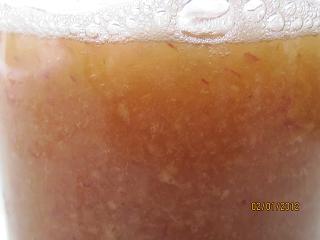
I decided to smash the apples to ferment faster and stronger. I think that Ron ( Ronray) did this too) If you don't like the color, you don't have to do it.
3. Tonight, I will loosen the jar to let my apple yeast water breath.
To be continued....
助け合うことはとても楽しいと思います。
Akiko
I started my levain 2 days ago and have been building it up. Today it more than doubled in 8 hours and I will make some semolina bread with it starting tonight so I can bake it off tomorrow. I also refrigerated mu YW today but before I did, I fed it and I started a new one with 60 g apples (no skins), 60 g minneola pieces (no peel) 60 g minneola juice, 15 grams of sugar (since I added juice and it has sugar) and enough water to cover the apples. I shook it hard every hour for 4 hours topped up the water level and in 8 hours is was very bubbly and vigorous. Now I can take care of my YW thanks to you !! You have been very generous and the best of help.
Arigato
寛大さが、親愛なるを保持する、最も困難な文字属性です。konnichiwa dabrownman,
After you made one yeast water, and you make another one which means refresh, you don't have to shake the jar so many often ( it is fine but you don't have to take care of it so much). To ferment the refresh one, put all of the ingredients in the jar, and shake it vigoursouly and keep it at 76-82 F ( now the yeast water is strong enough to ferment at the colder temperature ) for 12 hours. 12 hours later, you can shake the jar vigorously and store it in the refrigerator. All of the grinded fruit will be floated up arount the top when it is fully fermented. :)
寛大な気持ちを持つことは大切ですね、
Akiko
my New baby Minneola / Apple YW to breath tonight. Tomorrow morning I will make Semolina bread with its levain!!! I also like grinding up the apple and minneola pulp like you did and I will do that tomorrow too. Tomorrow is a big day - my 60th birthday!! I am driving my motorcycle down to Tucson to see my daughter, who is in college at the U of A, for a birthday treat.
Arigato
良いパンを酵母水が欠かせないどういたしまして dabrownman,
Happy birthday to you! and very very good news for your yeast waterS!! I am so glad that your levain and your yeast waters doing well. I saw you left a comment on the semolina bread post. Are you going to try the recipe using your levain? If it is right, I will be interested in your result.
Nice to hear the another progress of your new one. Grinding up of your apple and minneola pulp sounds luscious.
What a great treat to drive your motorcycle to see you daughter. What is the U of A?
おいしいパンができるとよいですね!
Akiko
Here are some of the facts and pictures.
Levain - 120 g ( 20g YW & 20g AP flour 12 hours, add 20 g YW and 20g flour 12 hours later, then 40 g AP flour 4 hours later. Kneed final and let ferment 8 hours - all at 82 F
semolina - 400 g
water - 300 g
sugar - 15 g
olive oil - 50 g
salt 10 g
Paddle mix Levain and water in mixer until levain is absorbed. Add everythong else and kneed with dough hook 8 minutes until dough passes window pane. Put in oiled bowl and let rest 60 minutes. Do 4 stretch and folds each time in the bowl 3 times every 30 minutes. Form into loaf and place in pan that is coated in non stick spray. Let rise until top of loaf is level with top of loaf pan. Preheat oven 45 minutes to 400 F place steaming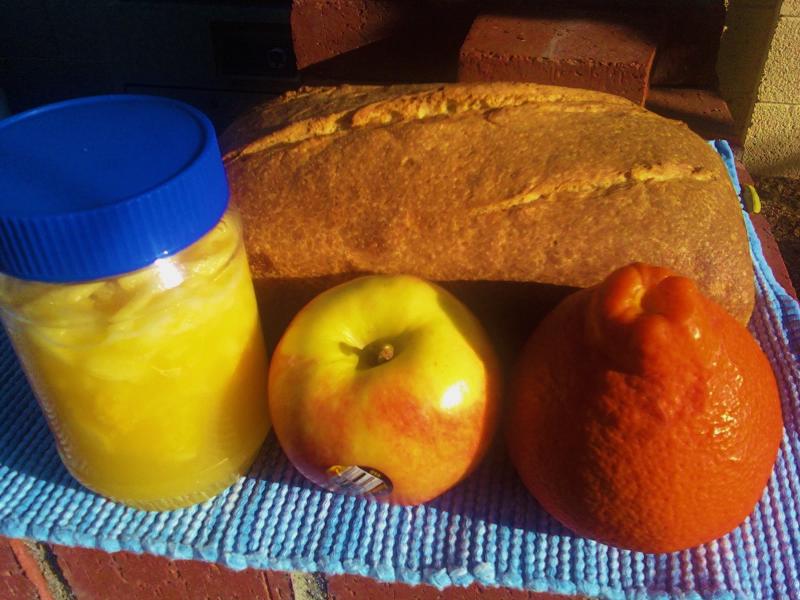
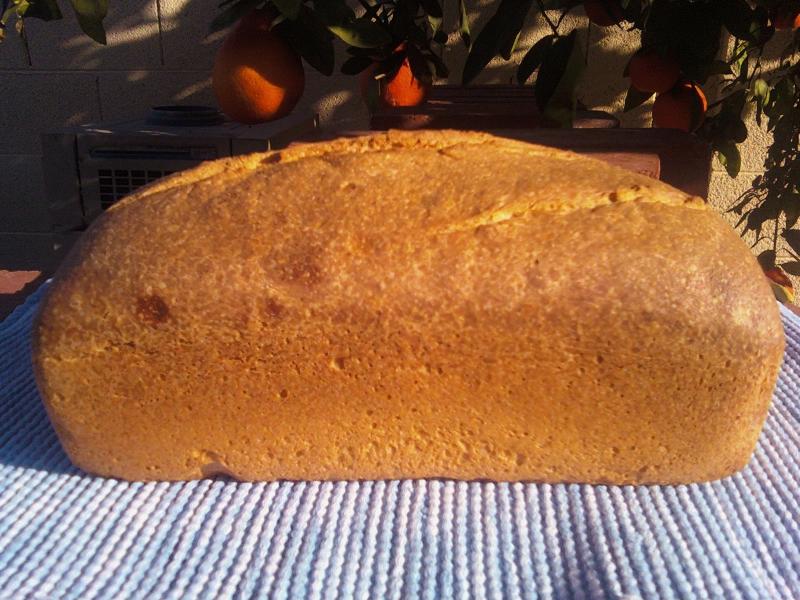

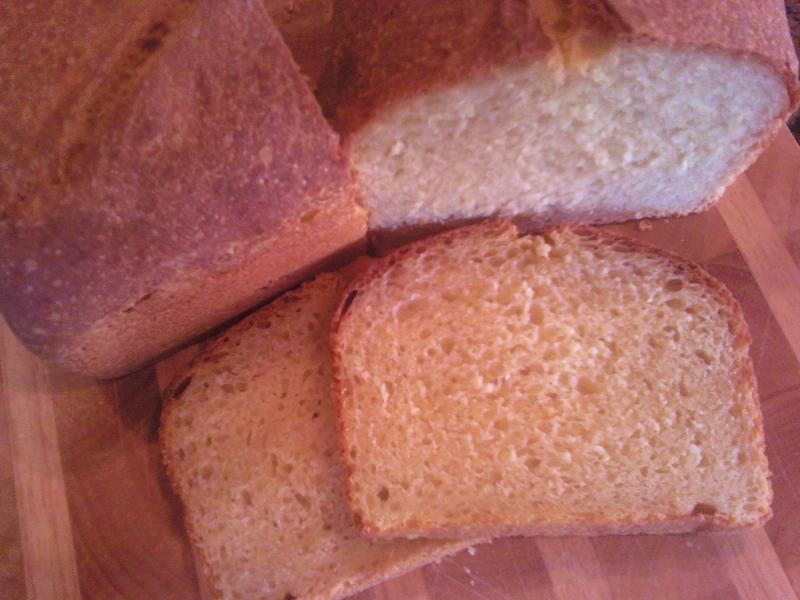
 apparatus in the oven. Put bread in oven, turn down to 375 and steam for 20 minutes , remove steam and backe on convetion for 20 minutes more. Take loaf out of pan and continue baking until loaf hits 200 degrees in the center.
apparatus in the oven. Put bread in oven, turn down to 375 and steam for 20 minutes , remove steam and backe on convetion for 20 minutes more. Take loaf out of pan and continue baking until loaf hits 200 degrees in the center.
Hi Dabrownman,
Wow, That looks fabulous! Very nice and fluff crumb. Congratulation for your yeast water levain loaf! How was the taste?
I am curious about the taste...
Happy birthday,
Akiko
I was in a rush this morning tryong to get the bread made, photos done and post to you about the Semolina yeast water bread before I got on my bike and went to the University of Arizona in Tucson to spend the day with my daughter, She is a Junior there and doing very well in micro and cellular biology. She is on a full scholorship and wants to be a doctor some day. I showed her your WOW post and she wanted to know why I didn't bring her any of the bread I have been baking every day!!!
One note on the semolina bread is i left it the oven with door open and oven off at the end for 10 minutes to let the crust get real crispy and crackly. The taste was good with no taste of yeast water, minneola or apple, It tasted like normally yeasted semolina bread. No taste of sour at all. It is great toasted though - but what decent bread isn't? I had it toasted tonight with whole berry cranberry sauce as a sorrt of jam. This morning I toasted it with home made dragon fruit and prickly pear cactus jam. I personally favor sourdough, but those who don't will like this bread a lot. The crumb is very yellow, moist, slightly sweet and it has that distinct semolina taste since it is almost 100% semolina except the 80g of AP in the levain. I am very happy with it overall, and with the Minneola / Apple yeast water. I want to thank you again for your kindness and generosity. Now i need to find another recipe for this YW, Any ideas?
人は、パンによって1人で生活することができません。しかし、それも彼を殺さないでしょう。
Thank you for your kind words, dabrownman.
I am happy to hear that you seemed having a good birthday with your daughter.
Wow, You must raise her in the good circumstance. I am glad to hear that you have a very smart daughter.
We can't make sour bread with yeast water if you use 100% yeast water ( too much yeast ) as to 100% preferment flour in the levain,which I found out recently. It is good for me to make white sandwich bread, bagel, English muffin or croissant that I don't need sour flavor to them.
Here is the recipe that I am making sour bread with raisin yeast water that I make very often.
Here is the PDF if you can't read well.
Method:
1. Levain- Ferment it for 12 hours at the room temperature. ( About 76F )
2. Next morning: Mix all of the ingredients except the salt. When I finished mixing the dough, the dough temperature is round 75F. My kitchen temperature is 65F in the winter.
3. Autolyze for 30 minutes
4. Add the salt and knead for 15 -20 minutes until the dough is elastic. DDT 70F
5. Bulk fermentation 4-5 hours at 74-76F. ( I will keep the dough at the colder temperature in the summer. )
6. Preshape and bench time for 30 minutes.
7. Final proof : About 2 hours at the room temperature arund 70F. or leave it for 30 minutes at the room temperature and retard it for 12- 16 hours, and bring it back into the room temperature ( 65-70F ) for 1-1.5 hours or so. Please watch the dough when it is ready to bake. I don't think a finger test is reliable. It didn't work for me. I am still thinking about the dough how to determine the timing.
8. Bake 465F for 12 mintues with steam, 425F for 8 minutes, and 400F for 25 minutes until golden brown.
You seem very good at baking your bread in the oven to make good crust. I use the method when I make baguettes. :)
My family and I prefer 80% hydration levain.
* You can skip the sugar ( molasses and honey).. I add the sugar to make thin crust that my family can eat easily. My family prefer thin crust, especially when we eat sandwiches.
You can retard it for 12 -16 hours to make sourer bread. This levain's hrdration is 80%. If you want complex stimulas flavor in the bread, 100% hydration is better for you. Don't add yeast water. Just adding more water to make 100 % hydration dough. And you have to decrease the water at the final dough to make 65 % hydration in total. 100% hydration levain ( liquid levain) tastes sweet and sour strongly at the same time as soon as I had in my mouth. 60% hydration levain ( stiff levain) tastes sour gradually ( slowly ) whenever I chew, and the milder sourness remains at the end of eating. So it is up to you to make a decision to make your bread. Yeast water percentage is 53% as to 100% levain flour to make sour bread. I add 3% yeast water as to total flour including levain( preferment ) flour to make fluff ( soft ) crumb such as in Jefferey Hamalman's bread is used instant yeast at the final dough.
I have my blog that I posted "Rustic bread with raisin yeast water " which will be the Rustic bread with raisin yeast waterⅠ because I haven't posted this recipe on my blog yet. You can try this first one without instant yeast water, which will be more like Tartine country bread or David (Dmsnyder )'s miche.
P.S Apple have the highest percentage of malic acid . It may difficult for you to get to sour flavor that you like in your bread, but I don't know how your apple and tangelo yeast water turns out. I will be curious about the taste of your bread. Fruit has malic ( mild sour ) and citric ( very sour ) acid.
I will report my apple yeast water later... I stored my apple yeast water in the refrigerator in the morning.
To be continued...
”パンは人によって作られ絶滅することはないでしょう" と、いうことかな?
Akiko
A very handsome bread. What fine crust and crumb!! Thanks for your recipe and formula spreadsheet. I will be making it soon. You are a big help with my Yeast Water project.
パンのかけらの小さく大きな穴、イースト水で可能である。
Thank you so much for your huge compliment! I am glad to help you out!! Please let me know if you make the bread, even if your failed. :)
水と粉とイーストの力でパンができるのですね。 単純だけど奥が深いですね。
Akiko
Fear, especially fear of failure, is very far from me. Sometimes failing is the only that will pint you to actions that lead to success.
I will practice my slashing with my Samurai sword so that when I use the razor on the baggies it will not seem so intimidating :-)
失敗したパンについて心配しないでください。
パンはあなたを傷つけないでしょう。
Day 3
1.
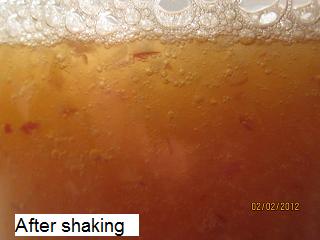
I could hear " Shw..." slightly.. The apples floated up to the surface, but it still needs more time to ferment.
I kept the jar loosen ( not to tight, not to loose ), and shook the jar 6-8 times in total. I was little busy at the day. I heard some little pop sounds just before I opened the jar after shaking vigorously.
Day 4.
1.
 This is the good sign of fully fermentation.
This is the good sign of fully fermentation.
To be continued...
Akiko
Here is the 5 th day of my apple yeast water:
I shook 2 times in the morning and night.
6th day:
I also refreshed ( make another one to keep ) the apple yeast water at the night. I will ferment it at 76-78F for overnight. You don't have to stick with 80-82F temperature anymore after you get one mother yeast water.
My bagel levain didn't rise as usual in 12 hours. I will tell you more details later.
But I want to warn not to use sugar to ferment any kind of fresh fruit when you start. Using Honey is a right decision to start with.
I totally forgot that I used sugar instread of honey.
How to make apple yeast water --7 th day:
So, I stirred the dough with a plastic fork to activate the yeast ( to get some oxygen in the dough to breath ) *NOTE It activated the yeast by stirring sourdough starter ( I made from flour and freshly squeezed apple juice instead of pineapple juice ) for a couple of times a day during the first stage. (that is what I have tested to make sourdough for 10 days, and it works. I am going to make more sourdough with flour and water next time.)
I will post the refreshed one when I take a picture of it tonight.
Fruit yeast water gets along with honey which contains fructose, but sugar doesn't have. It is good to use sugar when it is refreshed, but it is not so good to use sugar to make fruit yeast water at the beginning.
To be continued...
looks very good and should have made the Bagels rise well. Sugar failed and you should have used honey? How odd that it would work so well in the levain but fail to nake the bagels rise? It took me 3 days of increasing build to get my YW levain strong enough to use in the semolina bread.
Yes, I could make good bagels. :) However, it took longer than usual. I think that newborn yeast is not stable enough to rise properly, as you may have experimented.
Happy bubbles,
Akiko
Here is the bagels with the apple yeast water.
It took 6 hours until ready to bake. It usually takes 2-3 hours with raisin yeast water....
I tasted apples at the end of eating like this...
************** Refreshed apple yeast water *****************
I didn't put it in the refrigerator in 12 hours because I heard the sounds of " SHWWW" slightly...
I stored it in the refrigerator after shaking vigorously and tighten the jar. Hopefully, I can make a sandwich loaf soon... I wonder if I better feed honey instead of sugar...
To be continued...
and like to make them but can't seem to get them round with the right holes . I never would have thought of making them with YW. The long rise must have been because the YW wasn't up the job yet - but it will be. My semolina bread also took a longer time to rise than normal about 20% longer. Did you use Malted Barley Syrup in the water to get that nice color? How was the chew and taste? Bagels are all about the chew and taste for me :-)
ベイグルは作るのに楽しいが、食べることがよい。
Thank you for your kind words as always, dabrownman!
Yes, I agree with you completely.. New born baby yeasts take longer to rise. I put some molasses in the boiling water to have nice brown color. The bagel has a lot of volume, but the inside of crumb is kind of soft but looks dense.
By the way, I made Japanse sandwich loaf with apple yeast water yesterday. It took like FOREVER until I finish baking it. 10 hours for bulk fermentation, Final proof.. 2.5 hours at the room temperature around 80F, retarding for 10 hours in the refrigerator, and real final proof for 5 hours at 65F to 78F. It didn't rise well at the final proof, but it rose quite well in the oven.
P.S Now I wonder if apple yeast water itself doesn't have strong yeast as much as the other kind of fruit.... I make sourdough with apple juice intead of pineapple juice using sourdoughlady's method. It took FOREVER again to finsh baking... May be .. because the yeast is still not mature... I will work on this ... :)
Happy bubbles!
Akiko
patience comes to those that wait....a long, long time. I made Ping's orange turmeric bread today and I know what you mean. I don't have patience though. I know that my YW levain was strong it more than doubled in 6 hours after the 3rd feeding and I didn't have any trouble with it on the semolina bread. But, I bulk fermented it at 75 f for 4 hours with a S&F every hour. Hardly rose at all. Decided to do the retard as Ping did for hers SD version. 9 hours later I started again with 5 more hours of bulk ferment and it finally rose about 70% I just couldn't wait any longer and baked it off. It had some half decent oven spring but it should have been better in height - like your loaf that waited on........you did the right thing and I should have waited another 3 hours. It is the best smelling bread I have ever sniffed . Just a great aroma. The Various Orange and Apple YW really complimented this bread. I will post it later today. The smoked pork jowl, aged cheddar cheese and caramelized onion batard came out great today though and I feel good about that.
Your AYW white loaf looks absolutely perfect!!! I am going to do the YW baggies next though :-)
Thanks for all of your help and advice Akiko
Do you like chewy crumb? Personally, I don't stretch and fold after 45 minutes of bulk fermentation because I prefer softer crumb. Stretch and fold is good to strength dough and encourage to rise...but it is too chewy for me. If it is used instant yeast, it doesn't get so chewy though..
For natural yeasts.. I think that being patient is the key to make good bread. I was told that by the other experienced bakers too. Although I am glad that you seems having such good bread! It sounds very yummy !! I will check it out your blog..
Thank you for your compliment for my AYW white loaf. No wonder why Ron (Ronray) likes AYW very much.. But I still think that apple yeast water is weak.... I better try to test about it very soon...
I am learning from you, too. Thank you very much!!
Akiko
I got my MYW out of the fridge at 8 AM today to feed it and to make a levain to bake with on Monday. I fed it some Mandarin orange juice, honey, sugar and a half of an apple (now it is Mandarin, Minneola and Apple YW :-) After a couple of hours at 82 F it was perky again so I made a stiff levain that was half WW and half AP and have it at 82 F also. I was thinking about making a 70% WW sandwich loaf with it but wanted to know if you thinkit will have the power to lift such a heavy dough. It should be very active at 250 g by Monday and I plan on using it all for one loaf I'm guessing it will work OK even if I have to wait for it to double. What do you think?
Thanks for your help, as always
みかんイースト水音は非常によい
Hi dabrownman,
The temperature for levain: About 73 ( In the summer) -76F ( In the winter ). I like to leave my levain like that. Because there are a lot bacteria in the summer. You don't have to keep your levain at 82F.. Using whole wheat is good. It will ferment faster than white flour. It will be fine as long as your levain is active, but if you have softer crumb, I recommend to use 50% ww and 50% white flour ( bread flour recommended) for the first try for yw bread.
I am looking forward to seeing your result!
Yes, Your orange yeast sounds very active and nice!
down to 72 F after the 2nd build. It is 250 g now and in about 4 hours I should be able to use it. I changed my mind, baker's prerogative, and am going to make Ping's Orange and Turmeric bread with it. I thought it would fit the YW and the color is amazing.
Thanks for the levain temperature advice.
You are very welcome, dabrownman!
I saw you are trying many various breads that TFL members posted here. They look fantastic! It is very refreshing and exciting to try new recipes, isn't? Now I am playing with sourdough with only white flour and water. :) Exploring is much more fun to entertaining myself.
By the way, You might not get the answer from shiao-ping though.. She may be busy. I like her blog! :)
Happy baking,
Akiko
and her breads are even better. Thanks for the 50 50 advice on the WW bread. It will be next for the YW. I like baking all kinds of breads and deserts. Variety is the spice of life and there no sense getting bogged down with the same things. I bake what I am drawn to. I plan on baking as many different breads, as many different ways, as I can . That is why I am so interested in YW. It opens up entirely new horizons. After 20 years I might know something about bread - that is worth knowing:-)
By the way. The very best sunset s and sunrises I have ever seen were in Japan. No wonder they have the sun on their flag! I sold my pachinko machine though.
I agree with you. Shiao-Ping left a lot of wonderful formulas on TFL. I tried her recipes several times. They were pretty good.
You have made wonderful breads, you know!
Oh my goodness... You were in Japan... My city in Japan is near the ocean, so I used to see such a beautiful sunset and sunrise. Yes, the flag is exactly like that.... Pachinko machine?? LOL I am not good at any gambles... So I quit when I lost $200 at the Pachinko when I was 20 years old... LOL
Akiko
Wonderful breads I don't know about yet but, I am getting better day by day. I hope, practice will make perfect some day. I have been to Japan several times, a long time ago. Spent over an month there one time to get a real feel for the country and people. Loved the food, especially the fresh fish dishes, soups, udon, sukiyaki, yakitori, sushi, sashimi, green teas ....I love to cook Japanese and Chinese too. After returning from Japan, I actually went to a 2 week cooking school in SF Chinatown to learn to cook Japanese and Chinese correctly - couldn't make decent sukiyaki otherwise :-) It's all part of a well rounded culinary background and base to build new, original and unique recipes. I still think your YW white sandwich bread is top notch - now that is real rise and spring!!!
We won't talk about how much I lost at pachinko but the the Yakuza are still ..... very happy.... and miss me greatly!
You truly made me chuckles... I surely think that the Yakuza needs you! Oh my goodness... You sounds like a chef!! I also love the fresh fish, too. I can't get such fish here..... I miss all of the kind of Japanese food.. But.. When in Rome... I like finding something new food here. :)
Back to talking about your bread... Your breads are remarkable! I saw your Phil's walnut and sage loaf!! The converstation between you and phil made me laugh too..
And..
I have noticed that you use a brown bag for proofing your bread.... Why don't you use a plastic bag instead.. The plastic bag keeps the dough covered to protect from drying out. For buns, A big plastic bag is a good way to ferment. I got them from one of my friends when I tried croissants, and It really works well. I highly recommend it.
And one more thing... What kind of steaming method do you use? I was annoyed to see less oven spring on my loaves whenever I baked.. but I tried this method, and it worked every time.
Happy baking!!
Akiko
breads. I have been busy!! PiPs walnut and sage is baked in a cast iron pot so no steaming was required but it is funny, yesterday I was looking for a large stainless bowl to put over the round instead in the future but didn't find one the right size. I have tried two baled with a clotche, either my Wagner Ware Magnalite aluminum or my cast iron enameled pot and neither produced any spring at all in the bread. So I am going to try your way as soon as I locate a a cheap SS bowl at Goodwill. I have seen them there many times.
My usual steaming method is to put a half full of water Pyrex loaf pan on eh left side of the bottom rack and a 12 " cast iron skillet on the right side bottom rack and a stone on the next rack above and heat at 500 F for 1 hour. Then as the bread goes in I put a cup of boiling water into the iron skillet. This works every time I have used it and the bread springs as it should.
The brown paper bag was for storing the baked round overnight after it was baked. It was part of my story that the brown bag was the containment field to keep the purple people eater inside so I could take care of it in the morning.... with my bread knife. I too use tall kitchen trash bags to do my proofing in. It really is the best way if you don't have a proofer.
Thanks for your help and I do have your white sandwich bread on my YW schedule - it's next. Got to ge the YW out of the fridge and get it warmed up!!!
Oh I misunderstood about your brown bag! Sorry, dabrownman! I freeze any bread as soon as they are completely cool to keep fresh.
Well, I bought the stainless bowl at the Walmart. It was about 10 dollars, or less. It really worths to try the method. For the sage and walnut bread in the cast iron...Have you ever read this post?
http://www.thefreshloaf.com/node/20715/baking-bread-cast-iron-no-preheat-method
No preheating an cast iron and a lid makes good oven spring.
I want to try it too.. but I don't have a cast iron....
I am enjoying to see your posts! Thank you for sharing your various bread!
By the way, I make panko using my sandwich loaf . It makes really nice panko.
Happy baking!
Akiko
All the photo links in the original post (with raisins) are broken. Can someone fix this? Thanks!
Hello, tkarl.
I am sorry for this late response.
I have a blog for baking. So hopefully you can see all of the pictures in my blog.
http://raisinyeastwater.wordpress.com/2011/12/01/how-to-make-raisin-yeast-water/
http://raisinyeastwater.wordpress.com/category/how-to-maintain-raisin-yeast-water/
Good luck to your raisin yeast when you try. :)
I finally got my raisin water yeast going after seven tries and have my starter dough made and bread dough in the first rising. Now I need to know how to keep the raisin water alive and can I keep the leveling dough going in the fridge? Guess I am not understanding the posts about this. Please help!
I made two loaves of 100% whole wheat bread today using raisin water yeast and fresh ground hard red wheat. It turned out awesome and tastes oh so good. Thank you for all the help you have given me here. I am so grateful.
I made two loaves of 100% whole wheat bread today using raisin water yeast and fresh ground hard red wheat. It turned out awesome and tastes oh so good. Thank you for all the help you have given me here. I am so grateful.
i posted a picture of my bread, where is it?
Hello sskinnell,
I am sorry for this late response. Wow, your 100% whole wheat looks fabulous!
I would like to know what ingredients you used. So everybody who would like to try your bread would be very helpful. :)
Happy baking!
Akiko
raisinyeastwater.com linked at the top of this very old post has become a trap. I encourage its removal. It wants to install a "security" extension which is a clear give away that someone bad has taken it over.
https://raisinyeastwater.wordpress.com/2011/12/01/how-to-make-raisin-yeast-water/
Yippee
I worry about the person who clicks that top link and gets bitten.